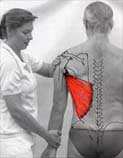|
Case Study - Psoas Reactive to Contralateral Neck Flexors
Robert Frost |
Case History Joachim, 37 years old, a banker, sturdy and strongly built, and plays soccer passionately on weekends. His main complaints were tightness in his upper trapezius and neck plus pain in the left side of the groin. He limped slightly and said that he couldn’t play soccer well because of weakness in the left leg. Examination Psoas weak on the left side. Abdominalis weak. Upper trapezius bilaterally hypertonic, latissimus dorsi weak. Treatment Left psoas, abdominalis and latissimus dorsi strengthened with neurolymphatic reflex massage. However, after tightening the upper trapzius, latissimus again became weak. Repeated spindle cell pinching (weakening) of upper trapzius was applied followed each time by Joachim tightening his latissimus dorsi by pulling his arm in toward his side. Several hard and painful areas of the upper trapezius had to be spindle cell pinched before this reactive condition was eliminated. Then Joachim could tighten his upper trapezius and latissimus dorsi subsequently remained strong-testing. |
 |
 |
|
Latissimus dorsi
|
Upper Trapezius
|
 |
|
Spindle cell pinching to weaken a muscle for reactive treatment
|
|
After strengthening the psoas, the groin pain was reduced considerably. However, after standing and making several atheletic movements, the pain returned. This indicated a probable reactive muscle involvement. Walther lists the contralateral anterior neck flexor as a possible reactive muscle to psoas. Further questioning revealed that before the groin pain had started, Joachim had taken a powerfully kicked ball and tried to deflect it into the goal using the right side of his head. This could easily have strained (over-strtched) the spindle cells in his right anterior neck flexors and thereby produced the reactive condition of left psoas weakness. |
|
|
 |
|
Right anterior neck flexor
Sterno-cleido-mastoidesu |
Left psoas
|
| Discussion The reactive psoas condition needed to be repeated two more times at two week intervals before it was completely eliminated. Joachim again plays soccer passionately. Reactive muscle pairs are often functionally oppose one another. In the first example above, upper trapezius elevates the shoulders and the reactive latissimus dorsi draws the shoulders down. But what about psoas and the contralateral anterior neck flexors? At first glance, they do not seem to oppose each other. But considering the trunk lying betweem them, one-sided psoas activity flexes the leg anteriorly and brings it in medially. At the other end of the trunk, one-sided activity of the main contralateral anterior neck flexor (sterno-cleido-mastoideus) flexes the head anteriorly and rotates it in medially. Looked at this way, psoas and the opposite side SCM do functionally oppose each other. A possible reactive condition between these two muscls should be considered in any case of recurring psoas weakness. |